
Kariga Mombe
Step by Step
text and graphics © Max Krimmel 2000 - noncommercial duplication and distribution
permitted, expected and encouraged
Kariga mombe is a wonderful Shona tune and a great place to start (or continue) your mbira playing. At its core it is very simple, and yet, as you will see, playing the variations can be quite challenging. Keep in mind that different teachers may consider the "beginning" of this song in different places. Mbira songs have no formal beginning, the bar lines and measure numbers (or phrase numbers) are for reference only. For some additional mbira information see the Mbira Jumpstart.
Step 1. The Core Kushaura Part. It's 24 pairs of notes. Looks easy doesn't it. It is. Memorize this, memorize it in your ears, in your fingers, and even as note names and intervals if you can. If it looks and/or sounds boring, just wait.

Step 2. Get the Beat in the Proper Place. I intentionally left the bar lines and time signature out of the above example. The correct meter is 12/8 with four groups of three eighth notes in each measure, each eighth note group is one beat. So, tap your foot, or use a metronome, to play four beats for every six pairs of notes on the mbira. Like this...

Step 3. Create a Simple Kutsinhira Part. Stagger your right and left hand notes, starting with the left hand. Don't forget that beat, it alternates between the left and right hand.
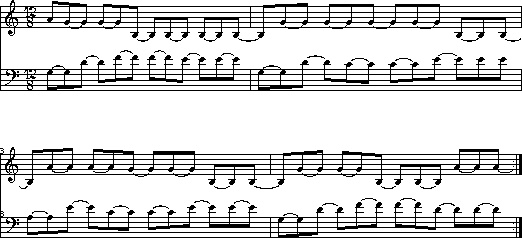
Step 4. A Slightly More Complex Kutsinhira Part. Drop every other repeating left hand note down an octave. Then, find a friend and another mbira and play the basic Kutsinhira and Kushaura parts together. Be sure to at least keep the beat in mind and even better get a third friend to clap. Is it starting to sound Shona? Take a deep breath for a few days and we'll add some high lines.
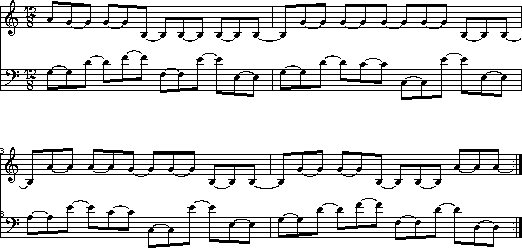
Step 5. High Lines. As you are playing Kariga mombe you may start to hear short melodies, groups of notes that seem to relate to each other but may cross over from hand to hand, or come from the combination of both mbiras playing together. If you do, good, if you don't, you will.
In the above example of a Kutsinhira part we substituted notes in lower octaves for their originals. In general, you can substitute either lower or higher octaves of any note. In this way these "high lines" are generated. Note that the left hand part is the same basic part.
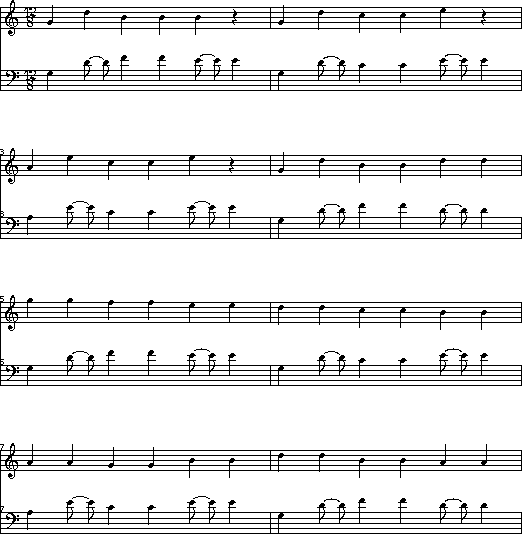
Step 6. Kutsinhira High Lines. It works for the Kutsinhira part too. One charming aspect of mbira music is the subtle changes the music goes through as it repeats. The Kushaura player may start to play some octave substitution, then the Kutsinhira player picks it up, maybe changes it a bit, and so it goes, round and round. And somewhere in all that music the original song is still there. So, practice the high lines in a Kutsinhira part too.
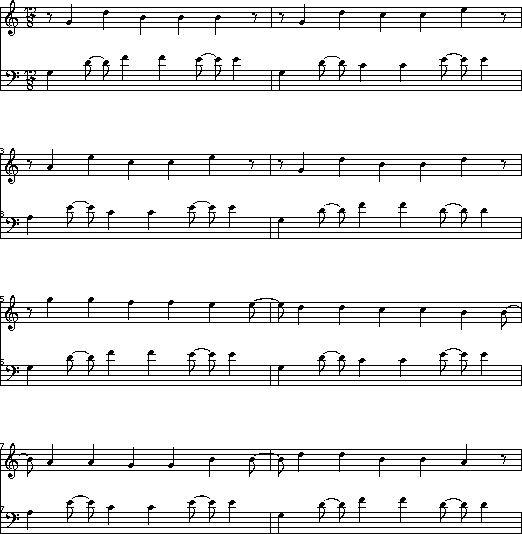
Step 7. Doubling. You can also double any note with its octave. Here's an example of doubling, or "cording" as it is sometimes called, in the Kushaura part
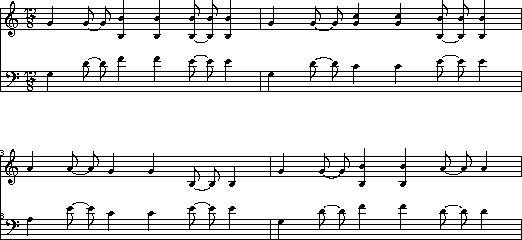
Step 8. Bass Variations. This is another example of octave substitutions.

Step 9. A Very Typical and Beautiful Kutsinhira Part. I learned this from Cosmas Magaya. Let's look closely at it. All the notes are either octave substitutions or doubles of the original parts. There is a definite repetitive kinesthetic pattern to this part, 1st a left hand note, 2nd a left hand note and right hand note(s) together, 3rd a left hand note, 4th a right hand note. This finger pattern creates a typically Shona rhythm, the left hand is playing a pattern of three eight notes followed by an eight rest throughout the whole round. This creates a feeling of three beats to the measure. The right hand is playing six evenly spaced notes per measure, but, if you were to be hearing this in a 6/8 meter, they are all off the beat. Meanwhile, the "real" beat, toe tap or hand clap is the 12/8 meter, which doesn't fit the feeling of either hand, a perfect audio milieu for inducing a trance.

Step 10. Mix it Up. Any high line can be played with any bass line. I'm not going to write these out for you. By this time you probably have a pretty good handle on the combinations.
Step 11. Uh-Oh. Just for grins, here's a decidedly un-Shona version. The Right thumb is crossing over into left thumb territory and in doing so rearranging the original four phrases into three phrases. An easy way to understand this is to think of the original four phrases as each having six beats (as you probably started out feeling it), then divide those twenty four beats into three groups of eight.
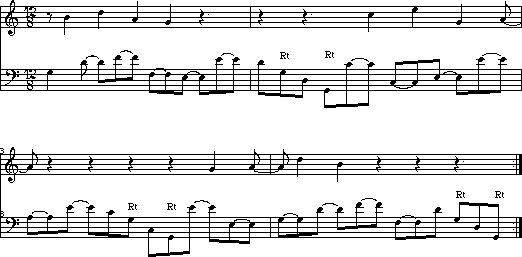
You can get out of this mode by playing an ascending line in the fourth measure and then picking up the Shona high line as it comes around, like this.
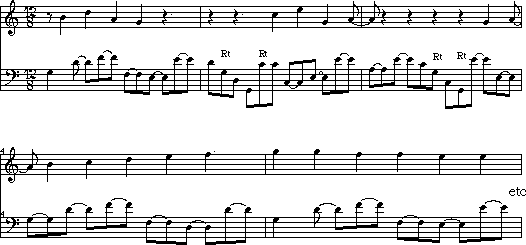
Step 12. Warigamukono. Marimba ensembles frequently play a version of Kariga mombe concocted by Dumisani Maraire and called Warigamukono. The key (and mode) are changed. This brings up an interesting question, what key (and consequently what mode) is the original version in? This depends on what you hear as the tonal center of the piece. It's either in Mixolydian G or Ionian C, Warigamukono is then either in Ionain C or Lydian F. You can play Warigamukono on the mbira too. Here's a basic Kushaura and rather elaborate Kutsinhira part to Warigamukono, take note of the fingering in the right hand for the Kutsinhira (T=thumb, 1=index finger, 2=second finger).
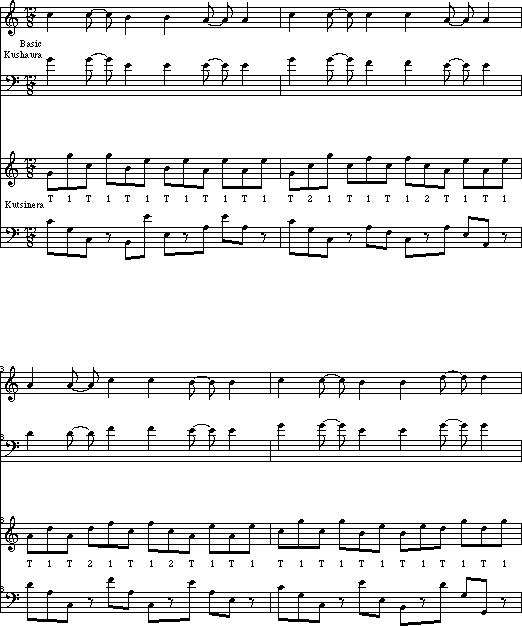
Step 13. Sometimes Kariga mombe is played with the beat flipped to the other Kushaura notes. The notes that were on the beat are now off the beat and vice versa. When the Kushaura is played with this flipped beat the Kutsinhira in step #9 doesn't work. Here's an example of the flipped beat placement with a different Kutsinhira from Cosmas Magaya. Notice that the Kushaura part has the same note pairs, note order, and note durations as in step #2, only the beat placement has changed. This example appears to start in an odd place. This is where Cosmas starts when he teaches this part and a good reminder that mbira music really has no set beginning. An easy mistake to make when you are learning this Kutsinhira is to feel the beat on the lower note of the left thumb pairs. So be careful, the beat is on the higher note.
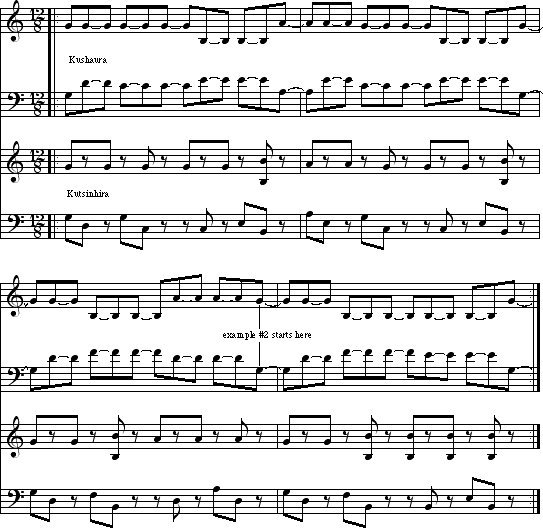
Home * Send
E-Mail * Site Map * Wood
Turning * Alabaster
Turning * Guitars * Shona
Music * Marimbas * Bio
© 2000 Max Krimmel non-commericial
duplication and distribution expected and encouraged
Max Krimmel - 4875 Sioux Dr. apt. 008 - Boulder, CO 80303 - 303-715-8275